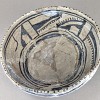
Type Name: Bandelier (Biscuit B) Black-on- (gray) white |
|
| Period: | 1400 A.D. - 1550 A.D. |
| Culture: | Ancestral Pueblo: Greater Upper Rio Grande Valley |
| Branch: | Northern Rio Grande |
| Tradition: | Greater Tewa Basin (Northern Tewa) |
| Ware: | Northern Rio Grande White Ware |
First posted by C. Dean Wilson 2012
Kidder (1915) initially defined Biscuit B which and in later descriptions also referred to similar pottery as Bandelier Black-on-gray (Kidder and Amsden 1931). This type was distinguished from Abiquiu or Biscuit A by the occurrence of slipped surfaces usually with painted decorations on both the exterior and interiors of bowls on forms displaying typical biscuit ware pastes (Kidder and Amsden 1931). Given similarities and connections to earlier Northern Rio Grande white ware types the term Bandelier Black-on-white is used here (Wilson 2008). While the criteria used to distinguish biscuit ware types is limited to bowl forms, a much wider range of forms including jars were produced during the time-span associated with the production of Bandelier Black-on-white (Kidder and Amsden 1931),and jar forms are discussed elsewhere in this document in a more generalized description of biscuit ware types. As is the case for other biscuit ware types, pastes reflect the use of bentonitic clays and added fine vitric tuff temper (Wilson 2008). Pastes are extremely soft and surfaces are easily eroded, and may sometimes make it difficult to distinguish Biscuit A and Biscuit B bowls.
While many of the rim forms are similar to those described for Abiquiu Black-on-white, there appears to have been a progressive heightening of rim form through the Classic period. Both interior and exterior surfaces are decorated with a black organic paint. The interior design covers most of the bowl surface. The overall execution of painted design in Bandelier Black-on-white appears to have declined through time, although decorations on some examples are well executed. Rims are commonly decorated with single evenly spaced ticks or by sets of several closely and evenly spaced ticking. Plain rims bear no further decoration but the inner sides are almost always embellished with zigzag lines, stylized birds, or oblique dashes. Both the interior and exterior surfaces are decorated with banded designs. The overall organization of interior designs is similar to those noted in Biscuit A. These panels are usually made up of combinations of triangles, dots and lines that are organized into similar panels that are separated by either single lines or a narrow space. These commonly form patterns present in lower frequency in Abiquiu Black-on-white that have been described as stylized Awanyu or stylized horned serpent (Hewitt 1953). Designs created through the use of straight, curved or zigzag lines are assumed to represent the body of the awanyu which often ends with a triangle pointing away from the line. This triangle is assumed to represent the head of the awanyu that may be solidly painted but is commonly open or filled with dots. Toward the end of the head, along the two more narrow sides of the larger triangles, is the basis of five smaller more narrow solid triangles. This creates a stylized effect resembling a plumed figure or an outstretched hand. Two or three of these stylized figures are often repeated on the vessel surface. Another form that is fairly common on these vessels is pendant triangles. These are filled in with evenly spaced lines with the broadest area being located along the rim and pointing toward the center of the vessel. These triangles are usually spaced apart and repeated two or three times. Other designs noted include stylized anthropomorphs which may include bird or masks forms and are similar to forms commonly noted on glaze ware vessels.
Late biscuit ware forms were produced over an area that includes the Tewa Basin, Pajarito Plateau, and Chama Valley (Mera 1934). Biscuit B forms were produced from about A.D. 1400 to 1550 (Breternitz 1966; Gauthier 1987; Wendorf 1953). Distribution of sites dominated by Bandelier Black-on-white are similar to those noted for those dominated by Abiquiu Black-on-white but is slightly more restricted particular for the southern margins of the Northern Rio Grande region (Mera 1934).
References:
Breternitz, David A.
1966 An Appraisal of Tree- Ring Dated Pottery in the Southwest. Anthropological Papers of the University of Arizona, No. 10. University of Arizona Press, Tucson.
Gauthier, Rory
1987 Ceramics. In Howiri: Excavation at a Northern Rio Grande Biscuit Ware Site, by D. Fallon and K. Wening, pp. 35–90. Laboratory of Anthropology Notes, 261b. Office of Archaeological Studies, Museum of New Mexico, Santa Fe.
Kidder, Alfred V.
1915 Pottery of the Pajarito Plateau and Some Adjacent Regions in New Mexico. Memoirs of the American Anthropological Association, vol. 2, part 6, New Haven.
Kidder, Alfred V., and Charles A. Amsden
1931 The Pottery of Pecos, Volume I, The Dull-Paint Wares. Papers of the Southwestern Expedition, no. 5, Yale University Press, New Haven.
Mera, H. P.
1934 A Survey of the Biscuit Ware Area in Northern New Mexico. Laboratory of Anthropology Technical Series Bulletin No. 8. Santa Fe, New Mexico.
Wendorf, Fred
1954 A Reconstruction of Northern Rio Grande Prehistory. American Anthropologist 56(2):200–227.
Wilson, C. Dean
2008 Ceramic Analysis for the Land Conveyance and Transfer Project, Los Alamos National Laboratory. In The Land Conveyance and Transfer Data Recovery Project: 7,000 Years of Land Use on the Pajarito Plateau, Vol. 3: Artifact and Sample Analysis, edited by Bradley J. Vierra and Kari M. Schmidt, pp. 125–256. Cultural Resource Report No. 273. Los Alamos National Laboratory, Los Alamos.
Related Photos
 © New Mexico Office of Archaeological Studies, a division of the New Mexico Department of Cultural Affairs.
© New Mexico Office of Archaeological Studies, a division of the New Mexico Department of Cultural Affairs.
The Center for New Mexico Archaeology
7 Old Cochiti Road
Santa Fe, NM 87507
505-476-4404
Fax: 505-476-4448






















